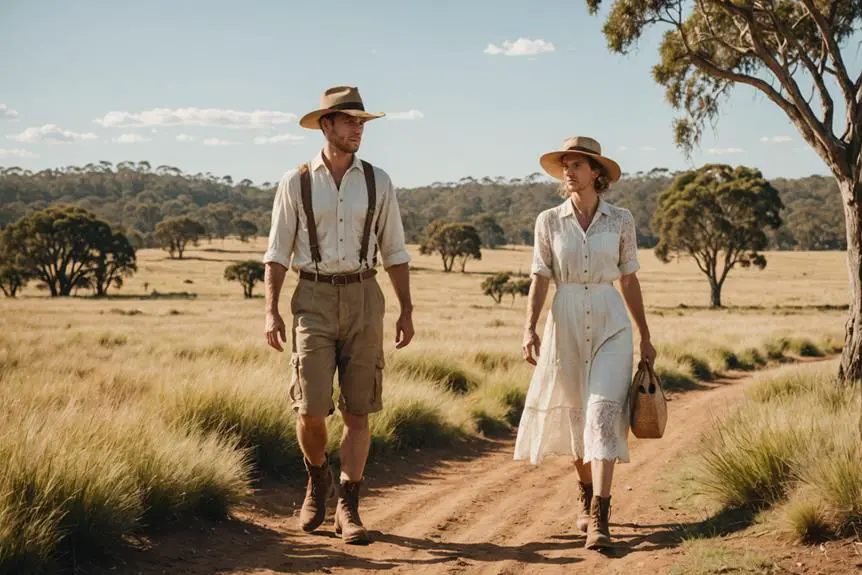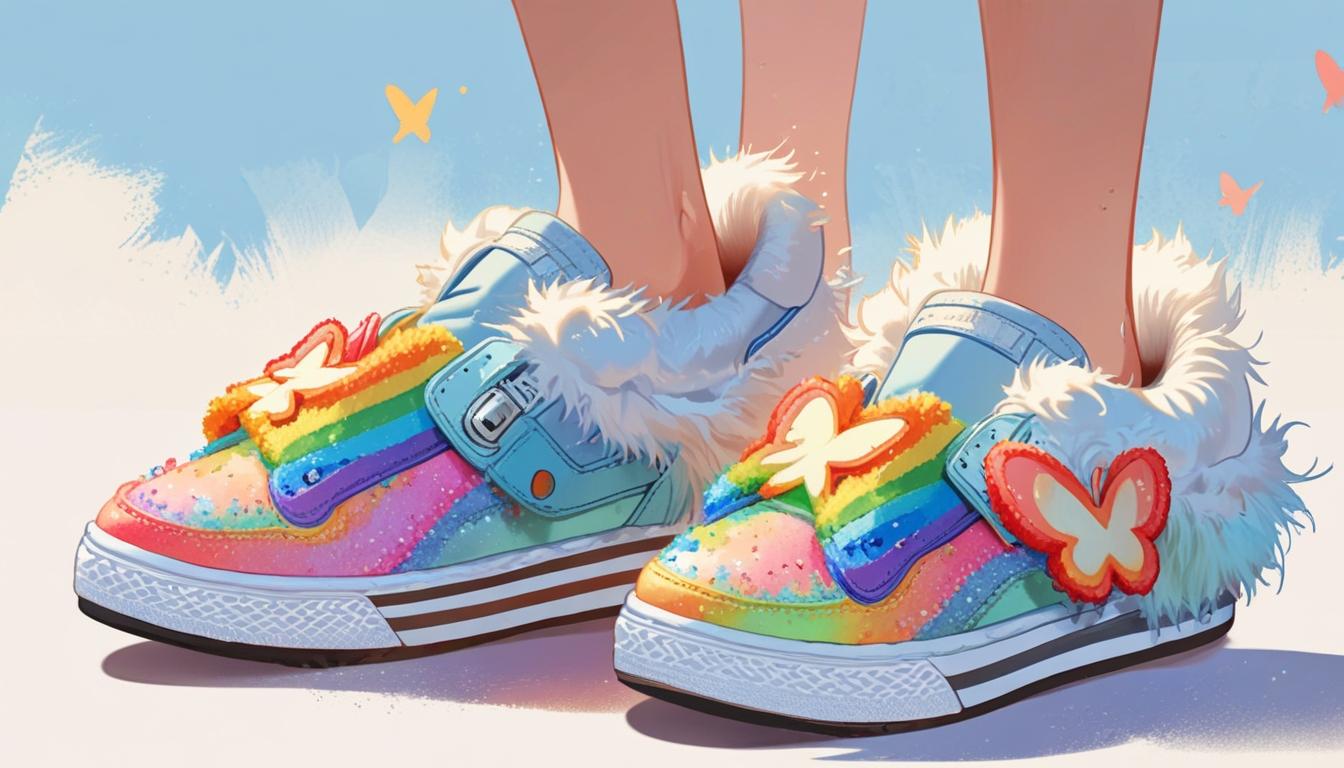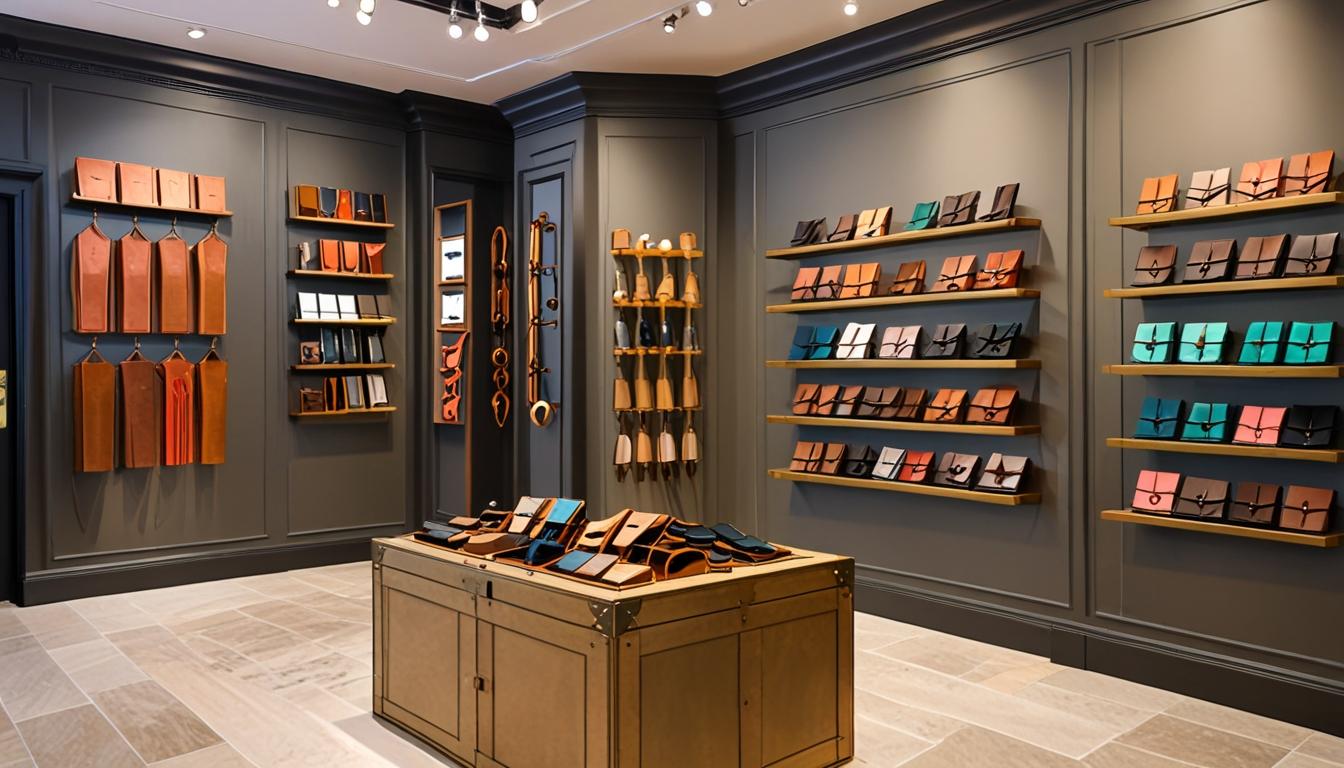When you think about *To Catch a Thief*, it's hard to ignore how pivotal the outfits are in shaping the film's luxurious atmosphere. Grace Kelly's iconic Ice Princess Gown and Cary Grant's effortlessly chic suits not only define their characters but also reflect the opulence of the Riviera. These costumes serve as more than just fabric; they communicate elegance, charm, and a hint of danger. But what do these choices say about the characters' deeper motivations and the era's fashion trends? The exploration of these symbols might just surprise you.
Overview of the Film
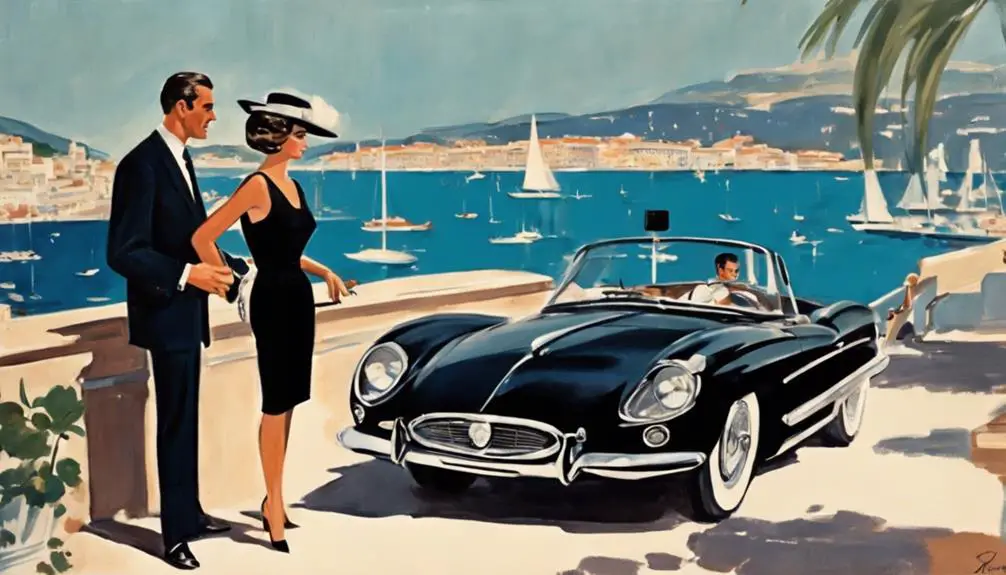
In *To Catch a Thief*, you'll find Cary Grant playing John Robie, a retired jewel thief who's been falsely accused of a new wave of robberies. Directed by the legendary Alfred Hitchcock and released in 1955, this film is a delightful blend of romance, suspense, and humor, set against the stunning backdrop of the French Riviera. The story unfolds during the summer of 1954, showcasing the luxurious lifestyle of American tourists and the opulence that defines this glamorous location.
As John Robie attempts to clear his name, he becomes entangled with Frances Stevens, played by the enchanting Grace Kelly, a wealthy heiress whose charm and wit add depth to the narrative. Their romantic chemistry fuels the film, making it a enthralling watch that beautifully balances tension and humor.
*To Catch a Thief* not only entertains but also enhances Hitchcock's legacy as a master filmmaker. The film received critical acclaim, winning an Academy Award for Best Cinematography while also earning nominations for Best Art Direction and Best Costume Design. The latter honor went to the esteemed Edith Head, whose innovative costume design helped define Grace Kelly's iconic style throughout the film.
This classic Hollywood gem remains a must-see for fans of romantic comedies and anyone interested in the art of filmmaking, showcasing both the elegance of its characters and the allure of its picturesque setting. You'll find yourself drawn into a world of intrigue and glamour that's hard to resist!
Iconic Outfits Worn by Grace Kelly
The stunning outfits worn by Grace Kelly in *To Catch a Thief* are a demonstration of her character's elegance and sophistication, all brought to life by the brilliant design of Edith Head. Each ensemble not only enhances her beauty but also reflects her character's wealth and allure, making her an unforgettable presence on screen.
- Ice Princess Gown: The icy blue evening gown perfectly embodies Grace's "ice princess" persona, showcasing her regal elegance.
- Retro Swimwear: The yellow halter top swimsuit, complete with horn-rimmed glasses and a swimming cap, highlights classic 1950s fashion, capturing the carefree spirit of summer in the film's beach scene.
- Floral Charm: Frances' morning floral dress, fitted at the waist with a white belt, adds a touch of feminine style that deepens the charm of her relationship with John Robie.
As the plot unfolds, each outfit plays a significant role in portraying the opulence and intricacies of her character. The strapless white gown she wears during a pivotal moment emphasizes her stunning necklace and symbolizes the tension in her relationship. Meanwhile, the elaborate gold dress at the costume party serves to highlight her jewels and the film's themes of theft and romance.
Grace Kelly's iconic outfits in *To Catch a Thief* are not merely clothes; they are a reflection of the 1950s fashion era, elevating her status as a style icon and forever leaving a mark on cinematic history.
Cary Grant's Stylish Riviera Looks
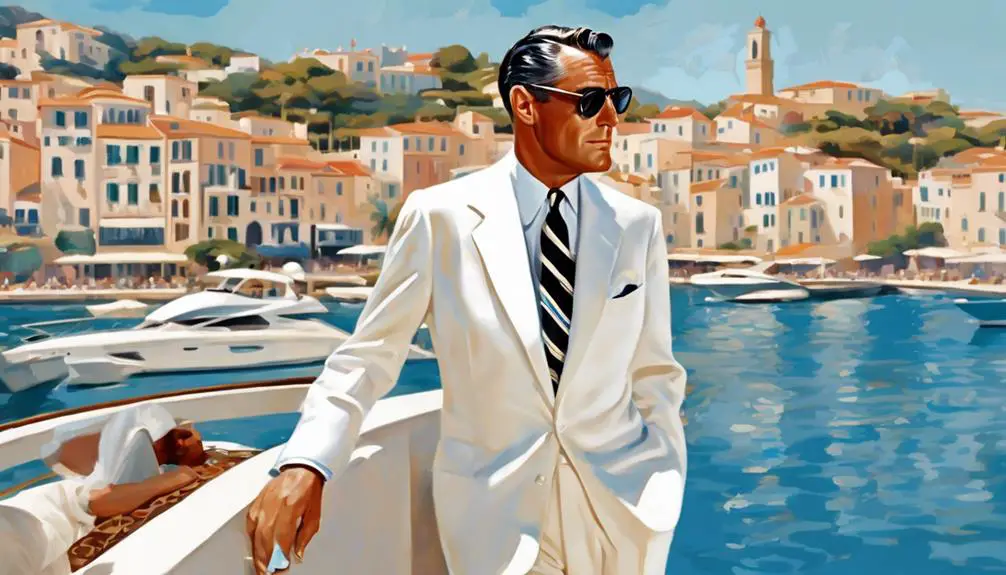
While traversing the glamorous Riviera, Cary Grant's character, John Robie, effortlessly embodies a blend of elegance and casual sophistication. His wardrobe is a masterclass in stylish living, showcasing outfits that perfectly capture the luxurious lifestyle of the sun-soaked coast. You'll notice his signature striped pullover, reminiscent of the classic Breton stripe, paired playfully with a red polka dot neckerchief, which adds a delightful flair to his ensemble.
The tailored slacks he wears elevate his look, reflecting the classic glamour associated with high-society gatherings. When he slips into a grey bankers suit, complete with a pristine white shirt and a precisely knotted tie, he exudes an air of refinement that aligns seamlessly with the film's upscale atmosphere. Each outfit not only highlights his impeccable taste but also fits perfectly, which is vital for portraying his enigmatic persona as a former jewel thief.
John Robie's casual swimwear, featuring red-and-green plaid swim trunks, showcases comfort while maintaining that essential stylishness typical of 1950s men's fashion. Cary Grant's meticulously crafted outfits, including hand-made loafers from Maxwells in London, further emphasize the importance of individuality and fit in his overall presentation. These fashion trends set by John Robie remain influential, proving that style and sophistication can be as effortless as a stroll along the Riviera.
Costume Design Significance
Costume design elevates *To Catch a Thief* by seamlessly weaving together visual storytelling and character development. Edith Head's stunning creations not only earned her an Academy Award nomination but also played a vital role in defining the film's glamorous aesthetic. The attention to detail in Head's designs reflects her mastery, akin to the intricacies found in identifying vintage fashion, such as vintage identification resources. You can see how Grace Kelly's outfits reflect her character's wealth and sophistication, portraying her as an "ice princess" who captivates viewers with every scene. Alfred Hitchcock understood that fashion could enhance character depth, and the collaboration with Head resulted in costumes that perfectly encapsulate the allure of 1950s fashion.
Consider the following aspects of costume design's significance in the film:
- Visual storytelling: Costumes set the mood and tone, immersing you in the luxurious world of the French Riviera.
- Character depth: Each outfit reveals something about the characters, helping you connect with their personalities and social status.
- Fashion influence: Grace Kelly's iconic pieces have shaped contemporary design, showcasing the elegance of the era.
Symbolism in Character Costumes

In *To Catch a Thief*, character costumes play an essential role in conveying deeper meanings and enhancing the narrative. Designed by the talented Edith Head, Frances Stevens' costumes are a feast for the eyes, utilizing pastel colors and flowing fabrics to embody her "ice princess" persona. These choices symbolize her wealth and sophistication, while also capturing her complex character development throughout the film.
On the other hand, John Robie's wardrobe tells a different story. His casual yet stylish pieces, like the striped pullover paired with tailored trousers, signify his dual identity as a reformed thief and charismatic gentleman. This blend of comfort and elegance reflects not just his past but his aspirations for a new life.
The contrasting earth-toned wardrobe of Jessie Stevens, Frances' mother, visually connects her to Frances while representing a different aspect of wealth—highlighting generational differences in style and perspective. Meanwhile, Danielle Foussard's youthful costumes bring forth her innocence and playfulness, showcasing the evolving dynamics between the characters.
One of the most striking examples of costume symbolism is Frances' strapless white gown worn during a pivotal scene. This gown embodies temptation and sophistication, emphasizing her strategic approach to seduction within the narrative. Through these carefully crafted costumes, you can see how wardrobe choices serve as powerful symbols, enriching the story and revealing the intricacies of each character's identity and emotional landscape.
Impact of 1950s Fashion
The impact of 1950s fashion in *To Catch a Thief* is undeniable, shaping not just the characters' identities but also influencing trends that resonate even today. You can see how Grace Kelly's iconic costumes, meticulously crafted by Edith Head, highlight the era's emphasis on femininity. With elegant silhouettes, fitted waists, and flowing skirts, her outfits not only reflect wealth but also the post-war desire for glamour. This era's fashion, much like the vintage styles of Polo by Ralph Lauren, showcases a timeless appeal that continues to inspire modern designers. Cary Grant, on the other hand, embodies the male fashion ideal with his casual yet stylish outfits, like striped sweaters and tailored trousers.
Here are a few key elements that define this influential era:
- Luxurious fabrics: The film showcases rich textures that elevate everyday attire to high fashion.
- Opulent costume design: Each outfit serves as a visual representation of the characters' personalities, enhancing storytelling.
- Timeless trends: Elements like cat-eye sunglasses and halter-top swimsuits remain popular today, proving the lasting influence of the 1950s.
The film's wardrobe effectively utilizes these trends, creating a vibrant tapestry of fashion that resonates with audiences. The combination of elegant silhouettes and casual outfits captures the essence of a time when style was paramount. By intertwining fashion and identity, *To Catch a Thief* not only reflects the 1950s but also sets a standard for cinematic costume design that continues to inspire designers and fashion enthusiasts alike.
Frequently Asked Questions
Who Designed the Clothes in to Catch a Thief?
The clothes in *To Catch a Thief* were designed by Edith Head. Her costume design showcases vintage style, vibrant color palettes, and wardrobe symbolism, enhancing character representation through designer collaboration and reflecting film aesthetics with iconic outfits.
Were the Jewels Real in to Catch a Thief?
The jewels aren't real; they're film prop replicas. This choice enhances jewelry authenticity and character wardrobe choices, while also influencing audience perception. It sparks historical accuracy debate and represents cinematic jewel symbolism in heist movie realism.
Who Did the Costumes for It Takes a Thief?
You'll find that *It Takes a Thief* showcases costume inspiration from vintage aesthetics. The designer collaborated to create iconic looks, blending fashion trends and color palettes that highlight character style and enhance the film's wardrobe choices.
What Hotel Was to Catch a Thief Filmed In?
You'll find that *To Catch a Thief* was filmed at the iconic Hotel Negresco, a stunning French Riviera location. Its vintage fashion and cinematic storytelling elevate Hitchcock's classic cinema, blending romantic suspense with masterful filming techniques.


